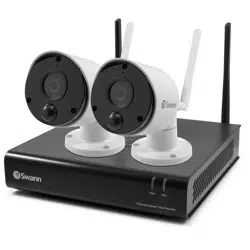Loading ...
Loading ...
Loading ...

Click for contents
69
Glossary
Live View: Is the default display mode for your DVR or NVR. Each camera
connected will be displayed on-screen.
MAC Address: Is a unique identifier for network hardware. Can also be used
as a super password if you have forgotten your current password.
Mainstream: Is the video stream that your DVR or NVR will display and re-
cord.
Mask: Is used to obscure part of your image for privacy. It can also be used
to minimise false triggers when your DVR or NVR detects motion. Any area
obscured won’t be shown live or recorded.
Menu: Is where you control the various actions and options that are available
on your DVR or NVR.
Motion Detection: Is the main method used by your DVR or NVR to detect
motion and is an essential part of your security system. It does this by com-
paring one frame of video with the next. A certain amount of difference be-
tween these two frames is interpreted as motion.
NAS (Network Attached Storage): A network device with one or more HDDs
that other network devices can use as if the storage was connected directly.
NIC (Network Interface Controller): The hardware component that allows a
device to connect to a network. Both wired and wireless NICs exist for these
respective purposes.
NTP (Network Time Protocol): Is used to synchronize your DVR or NVR’s
clock automatically with a network time server. Most time servers are on the
internet.
NTSC: Is the video system used in North America, Canada and some Latin
American countries. In NTSC, 30 frames are transmitted each second.
Optical Zoom: Is a true zoom feature. It allows you to zoom in (or out) on an
object to get a closer view by using the camera’s lens.
OSD (On-screen Display): Display information from the camera such as
time, date and camera name on-screen.
Overscan: Is mainly used on older television sets to display the entire view-
able area correctly on-screen. It does this by cutting off the edges of the pic-
ture. This is not required for modern Plasma and LCD TVs as the image is
digitally processed to display the correct aspect ratio.
Pack Duration: Instructs your DVR or NVR to split recordings into discrete
units. Each unit can be a maximum of 60 minutes in length. Your DVR or NVR
will play these as one continual video.
PAL: Is the video system used in the United Kingdom, Australia and most
European countries. In PAL, 25 frames are transmitted each second.
Post-record: Instructs your DVR or NVR to record for a set period of time
after an event has occurred.
PPPoE (Point-to-Point Protocol over Ethernet): Is the most common meth-
od that your router uses to login to your ISP to enable your internet con-
nection. This setting also exists on the DVR or NVR, but is only for advanced
users as the configuration required is difficult to complete and requires a
modem-only device (or a modem/router set to modem-only).
Pre-record: Allows your DVR or NVR to record for a number of seconds be-
fore an event occurs.
Privacy Zone: See Mask for information.
Resolution: The measure of detail that can be seen in an image. The higher
the number, the greater the detail available.
Loading ...
Loading ...
Loading ...
